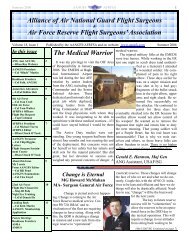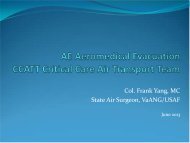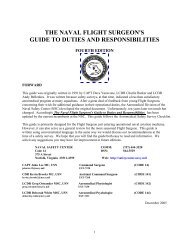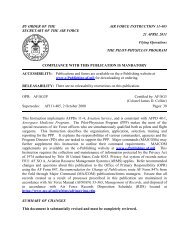ANGI 40-102 - Air Force Link
ANGI 40-102 - Air Force Link
ANGI 40-102 - Air Force Link
You also want an ePaper? Increase the reach of your titles
YUMPU automatically turns print PDFs into web optimized ePapers that Google loves.
BY ORDER OF THE CHIEF,<br />
NATIONAL GUARD BUREAU<br />
AIR NATIONAL GUARD INSTRUCTION <strong>40</strong>-<strong>102</strong><br />
11 JULY 2008<br />
Medical Command<br />
STATE AIR SURGEON<br />
ACCESSIBILITY:<br />
COMPLIANCE WITH THIS PUBLICATION IS MANDATORY<br />
Publications and forms are available for downloading or ordering on the<br />
e-Publishing website at www.e-publishing.af.mil<br />
RELEASABILITY: There are no releasability restrictions on this publication.<br />
OPR: NGB/SGP Certified by: NGB/SG (Col William S. Riggins)<br />
Supersedes <strong>ANGI</strong> <strong>40</strong>-<strong>102</strong>, 10 May 2002 Pages: 7<br />
This instruction governs the position of the State <strong>Air</strong> Surgeon (SAS) in the <strong>Air</strong> National Guard (ANG). It<br />
implements ANGPD <strong>40</strong>-1, State <strong>Air</strong> Surgeon. This <strong>Air</strong> National Guard Instruction (<strong>ANGI</strong>) prescribes the<br />
qualifications, duties, responsibilities, and both wartime and peacetime contingency requirements of the<br />
State <strong>Air</strong> Surgeon.<br />
SUMMARY OF CHANGES<br />
This document has been substantially revised and must be completely reviewed.<br />
1. Philosophy. The SAS enhances the ability of the ANG to properly perform its state and federal missions<br />
as the primary liaison between the individual medical/aeromedical evacuation units, the Adjutant<br />
General (TAG) and the <strong>Air</strong> Surgeon (NGB/SG) on force protection medical issues, medical aspects of<br />
homeland security and other medical matters. The SAS helps to ensure that the State maintains a viable<br />
and healthy force for worldwide deployment. The SAS coordinates with the State’s Army National Guard<br />
Surgeon as well as other ANG SASs within the Federal Emergency Management Agency (FEMA) region<br />
to identify military medical capabilities. The SAS coordinates appropriate use of medical assets mobilized<br />
for state or national emergencies and exercises staff oversight of ANG medical activities. Authority for<br />
this position is as follows:<br />
1.1. Appointed by the Adjutant General with concurrence of NGB/SG.<br />
1.2. Member of the State Headquarters staff as the senior ANG medical officer.<br />
2. Qualifications of SAS:<br />
2.1. Must hold the aeronautical rating of <strong>Air</strong> <strong>Force</strong> flight surgeon.<br />
2.2. Preferably has previous medical command experience.<br />
2.3. Should be an 0-6 or eligible for promotion to 0-6 with at least two years’ retainability.
2 <strong>ANGI</strong><strong>40</strong>-<strong>102</strong> 11 JULY 2008<br />
2.4. Must have Provider Credential File (PCF) approved by NGB/SG within ninety days following<br />
appointment as the State <strong>Air</strong> Surgeon.<br />
2.5. Must complete a one week certification training program at NGB/SG within one year of appointment<br />
as SAS and attend the Readiness Frontiers Symposium or equivalent within two years of<br />
appointment. Failure to complete the training negates authority outlined in Section 4 of this instruction.<br />
2.6. NGB/SG retains authority to waive any of the above qualifications.<br />
3. Mandatory Re-Qualification Training.<br />
3.1. At a minimum the SAS must attend an ANG annual SAS meeting at least every other Year<br />
(Readiness Frontiers, Association of Military Surgeons of the United States (AMSUS), etc.)<br />
3.2. Completes a one week recertification training program as directed by NGB/SG every five years<br />
in order to maintain waiver/certification authority.<br />
4. Duties and Responsibilities of SAS. As the senior ANG medical officer in the State, the SAS serves<br />
as consultant to the TAG for all medical issues. The SAS also acts as the liaison between NGB/SG and all<br />
medical units within the State.<br />
4.1. The SAS functions as the State Headquarters’ Surgeon General in addressing all ANG medical<br />
and aeromedical programs within the State. Specifically the SAS:<br />
4.1.1. Oversees all force protection medical requirements for all ANG members of the State.<br />
4.1.2. Ensures that a host Medical Group (MDG) is assigned to all Geographically Separated<br />
Units (GSUs) within the State. GSUs in states without a SAS will be assigned a host MDG by the<br />
commander of the State’s ANG headquarters.<br />
4.1.2.1. The commanders of each GSU and host MDG will be notified in writing of these<br />
assignments.<br />
4.1.2.2. A copy of the notification letter will be sent to Medical Operations Division (NGB/<br />
SGP).<br />
4.1.2.3. Ensures that support agreements are formally established between the host<br />
MDG and assigned GSUs in accordance with AFI 25-201, Support Agreements Procedures.<br />
4.1.2.4. Evaluates medical aspects of GSU support agreements annually, serving as a catalyst<br />
for issue identification and resolution<br />
4.1.3. Assists line and medical leaders regarding medical personnel issues and programs.<br />
4.1.3.1. Part of the Health Professions Recruiting/Retention Team within their State. Participates<br />
in an annual strategic planning process with the HP recruiting team. Coordinates the<br />
assistance of unit health professionals to unit/regional HP recruiters when requested<br />
4.1.3.2. Advise line commanders on medical unit commander selections and provide input for<br />
medical and aeromedical commanders’ officer performance reports.<br />
4.1.3.3. May serve as a member of medical officer promotion boards.
<strong>ANGI</strong><strong>40</strong>-<strong>102</strong> 11 JULY 2008 3<br />
4.1.3.4. May nominate members of medical organizations throughout the State for awards,<br />
decorations and promotions.<br />
4.1.3.5. Will perform/aggregate annual capability gap analysis data and forward to the<br />
regional SAS rep on the Human Weapons System Council. (See AFI 48-101, Aerospace Medicine<br />
Operations and 2007 HQ USAF/SG3 Policy Letter, for further details.)<br />
4.1.4. Advises TAG, state headquarters and line commanders, as well as medical organization<br />
commanders, on ANG medical/health programs.<br />
4.1.5. Ensures that support agreements are formally established between the host MDG and the<br />
squadron medical element in accordance with AFI 48-149, Squadron Medical Elements, and AFI<br />
25-201, Support Agreements Procedures.<br />
4.1.6. Serves as the ANG medical representative in support of the State Partnership Program<br />
(SPP), or appoints another senior medical leader from within the state to fill this role.<br />
4.1.6.1. Coordinates with the State Army Surgeon’s office to ensure medical participation in<br />
the SPP is joint whenever feasible.<br />
4.1.7. Serves as the focal point at state headquarters regarding ANG medical capabilities related<br />
to Homeland Response and medical support to civil authorities.<br />
4.1.7.1. Coordinates with SASs in other states within the same FEMA region and with the<br />
State’s Army National Guard Surgeon to identify synergistic medical capabilities.<br />
4.1.7.2. Serves as liaison between the Joint <strong>Force</strong>s Headquarters (JFHQ), formerly known as<br />
State Area Command (STARC) and state ANG headquarters and medical organizations for<br />
issues related to ANG medical capabilities and requirements.<br />
4.1.7.3. Works to establish bi-directional cross flow of information and capabilities awareness<br />
with State Health Departments for CBRNE events<br />
4.1.7.4. Helps integrate ANG medical representation into community National Incident Management<br />
System (NIMS) and Emergency Support Function (ESF) #8 functions.<br />
4.2. SASs will maintain an awareness of issues and initiatives facing each of the medical organizations<br />
to ensure that appropriate force health protection is maintained throughout the State.<br />
4.2.1. SASs will assist in the identification and resolution of problems, conflicts or other factors<br />
potentially limiting an organization’s mission readiness. Such awareness may be developed<br />
through formal site visits, either individually or as part of a headquarters’ team, or through informal<br />
methods including telephonic and electronic communiqués, or a combination of both. At a<br />
minimum, formal or informal visits will be accomplished annually at:<br />
4.2.1.1. Each GSU regardless of whether or not medical personnel are authorized/assigned.<br />
4.2.1.2. Each squadron with an authorized/assigned medical element (SME).<br />
4.2.1.3. Each MDG and Aeromedical Evacuation Squadron (AES) within the State.<br />
4.2.2. SAS will maintain an awareness of the Medical Regional Readiness Response (MRRR)<br />
that allows MDGs to forecast and schedule long-term training and exercise requirements.<br />
4.2.3. SAS will maintain an awareness of the allocation of existing resources, days and dollars<br />
that support and permeate the MRRR requirements in DoD FUNDS.
4 <strong>ANGI</strong><strong>40</strong>-<strong>102</strong> 11 JULY 2008<br />
4.2.4. The SAS will ensure the Self Inspection Database program (SID) is utilized within each<br />
medical organization and will assist with leadership initiatives and resource procurement.<br />
4.2.4.1. Review the unit SID reports and the Flight Deck report at least quarterly.<br />
4.2.4.2. Follow up on identified unit program discrepancies.<br />
4.2.5. In conjunction with NGB/SG staff, the SAS will assess unit plans and assist as necessary to<br />
rectify issues which led to a Health Services Inspection (HSI) overall finding of less than “Satisfactory”<br />
during the unit’s most recent HSI in the overall score as well as any of the seven major<br />
scored areas.<br />
4.2.6. SAS will furnish a written report to the TAG, the Assistant Adjutant for <strong>Air</strong> (AAG), the<br />
wing commander, the visited unit’s commander, the host MDG commander and NGB/SG detailing<br />
issues, concerns and recommendations. When formal visits have been accomplished, this<br />
report should be submitted as soon after the visit as possible (The TAG and NGB/SG should be<br />
notified in writing if the report will not be submitted within two UTA’s of the visit). When informal<br />
methods are utilized, the SAS will prepare an annual report. Note: SAS report template can be<br />
found on the Communities of Practice, ANG Medical Services Professional & Aeromedical Service<br />
Division page.<br />
4.3. Credentials:<br />
4.3.1. Medical privileges for the SAS will be awarded by the <strong>Air</strong> Surgeon (NGB/SG). The SAS’s<br />
PCF will be maintained at NGB/SG. If the SAS augments medical organizations outside of their<br />
state as a provider, the organization must maintain a privilege “Inter-facility Credentials Transfer<br />
Brief (ICTB) with a validity period encompassing that time the SAS serves as a provider.<br />
4.3.2. The SAS reviews the PCF and awards clinical privileges to all MDG commanders within<br />
their State. In the event of a non-physician commander, the SAS reviews and awards clinical privileges<br />
to the senior physician in the unit IAW AFI 44-119, Para 6.14.1.1.<br />
5. Medical Review, Certification, and Waiver Authority. As the senior medical officer within the<br />
State, the SAS must be aware of all medical issues in the State. As such all medical issues that may impact<br />
medical readiness of the unit should be brought to the attention of the SAS. In addition, the SAS must<br />
mentor the younger/less experienced medical officers in the State. To meet these goals, the SAS will:<br />
5.1. Act as the Senior Reviewer for all Worldwide Duty (WWD) Evaluations. This will facilitate situational<br />
awareness regarding the medical readiness and the quality of medical summaries within the<br />
State.<br />
5.1.1. Ensure quality and completeness of cases prior to forwarding to higher authority.<br />
5.1.2. Provide mentoring to constituent units on medical summaries.<br />
5.1.3. Brief the TAG/State Headquarters as needed on medical issues.<br />
5.2. Acts as the Senior Reviewer for all Physical Examination Processing Program (PEPP) cases.<br />
5.3. Acts as the Certification Authority for cases where the SAS has been delegated Certification<br />
Authority by NGB/SG.
<strong>ANGI</strong><strong>40</strong>-<strong>102</strong> 11 JULY 2008 5<br />
5.4. Acts as the Waiver Authority for cases where the SAS has been delegated Waiver Authority by<br />
NGB/SG. All flying and Special Operational duty waivers must be accomplished in Aeromedical<br />
Information Management Waiver Tracking System (AIMWTS).<br />
5.4.1. SAS may grant a waiver for members on a 4-T profile to attend inactive duty for training<br />
(UTA) at member’s home-station, for up to 12 months if the member is expected to return to<br />
Worldwide Duty Status. Waivers beyond 12 months must be approved by Physicals and Standards<br />
Branch (NGB/SGPA) after SAS endorsement. (Note: Dental Class 4 is NOT eligible for this<br />
waiver.)<br />
5.4.2. A copy of all Waivers granted by the SAS outside of AIMWTS or PEPP must be forwarded<br />
to NGB/SGPA.<br />
5.5. Reviews and Certifies medical examinations for transfers of all individuals of non-AF component<br />
military transfers. Cases with disqualifying/potentially disqualifying conditions must be sent to<br />
NGB/SGPA for Waiver consideration.<br />
5.6. Review and ensure quality/completeness of Medical Evaluation Boards (MEB) conducted at<br />
ANG Medical Groups. The SAS will act as the Reviewing Officer and sign on block 28 of the AF<br />
Form 618, Medical Board Report. Once complete, the MEB package will be forwarded to <strong>Air</strong> <strong>Force</strong><br />
Personnel Center (HQ/AFPC) for an Informal Physical Evaluation Board (IPEB) or a copy forwarded<br />
to Medical Disability Evaluations Branch (NGB/SGPD) for validation of Return to Duty.<br />
5.7. Review and validate Incapacitation (INCAP) pay packages. Review and ensure quality/completeness<br />
of all Incapacitation pay extension packages before the Adjutant General’s Signature. NGB/<br />
SG, Financial Management (NGB/FM), and Manpower & Personnel (NGB/A1) will no longer review<br />
packages for completeness. Packages will be forwarded directly to the Chief of Staff (COS) from the<br />
TAG for approval. (INCAP pay checklist- located on the Communities of Practice, ANG Medical Services<br />
Professional & Aeromedical Service Division page.)<br />
6. Assistant to the SAS: The SAS may appoint an officer or senior enlisted person from any medical<br />
organization the additional duty of assisting in the fulfillment of SAS duties and responsibilities.<br />
6.1. The appointment must have the concurrence of the member’s organization commander.<br />
6.2. The assistant to the SAS is prohibited from:<br />
6.2.1. Making credential/privilege determinations.<br />
6.2.2. Making determinations pertaining to certification and waiver authority.<br />
6.2.3. Other actions which require determination of a privileged provider.<br />
7. Mobilization and Contingency Missions. During a mobilization and with consent and concurrence<br />
of TAG and NGB/SG, the SAS may augment any state medical organization, any Unit Type Code (UTC)<br />
tasking for which the SAS is otherwise qualified, or HQ NGB/SG.<br />
CRAIG R. MCKINLEY, Lieutenant General, USAF<br />
Director, <strong>Air</strong> National Guard
6 <strong>ANGI</strong><strong>40</strong>-<strong>102</strong> 11 JULY 2008<br />
Attachment 1<br />
GLOSSARY OF REFERENCES AND SUPPORTING INFORMATION<br />
References<br />
AFI 25-201, Support Agreements Procedures, 1 May 2005<br />
AFI 41-106, Medical Readiness Planning and Training, 14 Apr 2008<br />
AFI 41-115, Authorized Health Care and Health Care Benefits in the Military Health Services System<br />
(MHSS), 28 Dec 2001<br />
AFI 41-117, Medical Service Officer Education, 23 Apr 2001<br />
AFI 44-103, The <strong>Air</strong> <strong>Force</strong> Independent Duty Medical Technician Program and Medical Support for<br />
Mobile Medical Units/Remote Sites, 1 May 2005<br />
AFI 44-119, Clinical Performance Improvement, 24 Sep 2007<br />
AFI 48-101, Aerospace Medicine Operations, 19 Aug 2005<br />
AFI 48-149 Squadron Medical Elements, 28 Feb 2003<br />
AFI 48-123 Vol 1, Medical Examinations and Standard, Volume 1-General Provisions, 5 Jun 2006<br />
AFI 48-123 Vol 2, Medical Examinations and Standards, Volume 2-Accession, Retention, and Administration,<br />
5 Jun 2006<br />
AFI 48-123 Vol 3, Medical Examinations and Standards, Volume 3-Flying and Special Operational Duty,<br />
5 Jun 2006<br />
AFI 48-123 Vol 4, Medical Examinations and Standards, Volume 4-Special Standards and Requirements,<br />
5 Jun 2006<br />
AFMAN 44-158, The <strong>Air</strong> <strong>Force</strong> Independent Duty Medical Technician Medical and Dental Treatment<br />
Protocols, 1 Dec 1999<br />
<strong>ANGI</strong> 36-2005, Appointment of Officers in the ANG of the United States and As Reserves of the <strong>Air</strong><br />
<strong>Force</strong>, 15 Mar 2005<br />
<strong>ANGI</strong> <strong>40</strong>-101, Annual Training and Planning Requirements and Procedures Local, 28 Jan 1994<br />
<strong>ANGI</strong> <strong>40</strong>-103, Medical Support to Geographically Separated Units (GSUs), 16 Jul 1995<br />
<strong>ANGI</strong> 41-<strong>102</strong>, Early Appointment Program for Physician, 30 Oct 1995<br />
<strong>ANGI</strong> 41-103, Annual Training, Planning Requirements, and Procedures for ANG Aeromedical Evacuation<br />
Units, 22 Dec 1995<br />
ANGPD <strong>40</strong>-1, State <strong>Air</strong> Surgeon, 21 Oct 1994<br />
Abbreviations and Acronyms<br />
AAG—Assistant Adjutant for <strong>Air</strong><br />
AES—Aeromedical Evacuation Squadron<br />
AFPC—<strong>Air</strong> <strong>Force</strong> Personnel Center
<strong>ANGI</strong><strong>40</strong>-<strong>102</strong> 11 JULY 2008 7<br />
AGR—Active Guard Reserve<br />
AIMWTS—Aeromedical Information Management Waiver Tracking System<br />
AMSUS—Association of Military Surgeons of the United States<br />
AT—Annual Training<br />
DoD FUNDS—Department of Defense Financial Uniform Needs Development System<br />
ESF-#8—Emergency Support Function #8 (FEMA)<br />
FC—Flying Class<br />
FEMA—Federal Emergency Management Agency<br />
GSU—Geographically Separated Unit<br />
HMDS—Host Medical Squadron<br />
HSM—Health Services Management<br />
IPEB—Informal Physical Evaluation Board<br />
LoD—Line of Duty<br />
MDG—Medical Group<br />
MEB—Medical Evaluation Boards<br />
NIMS—National Incident Management System<br />
PCF—Provider Credential File<br />
PEPP—Physical Examination Processing Program<br />
SAS—State <strong>Air</strong> Surgeon<br />
SAV—Staff Assistance Visit<br />
SME—Squadron Medical Element<br />
SPP—State Partnership Program<br />
STARC—State Area Command<br />
TAG—The Adjutant General<br />
UTA—Unit Training Assembly<br />
UTC—Unit Type Code


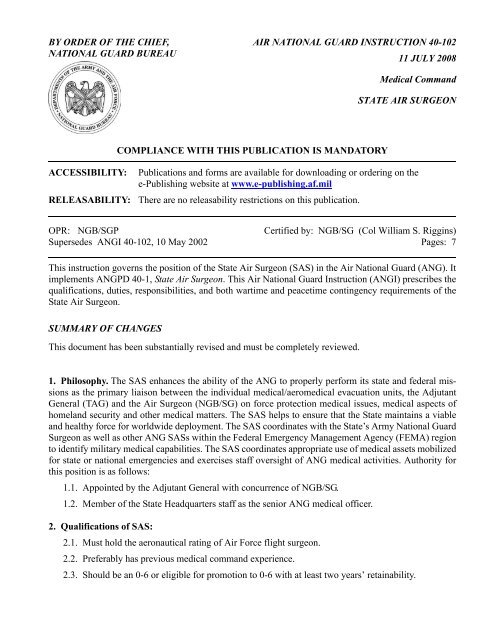
![[UNIT] MEDICAL GROUP [ADDRESS]](https://img.yumpu.com/51218535/1/190x245/unit-medical-group-address.jpg?quality=85)
